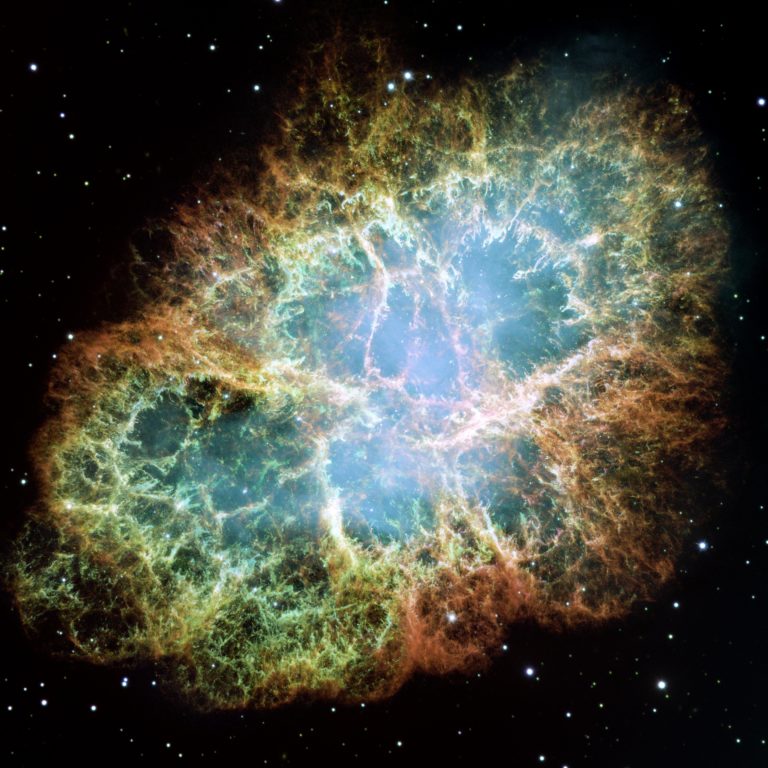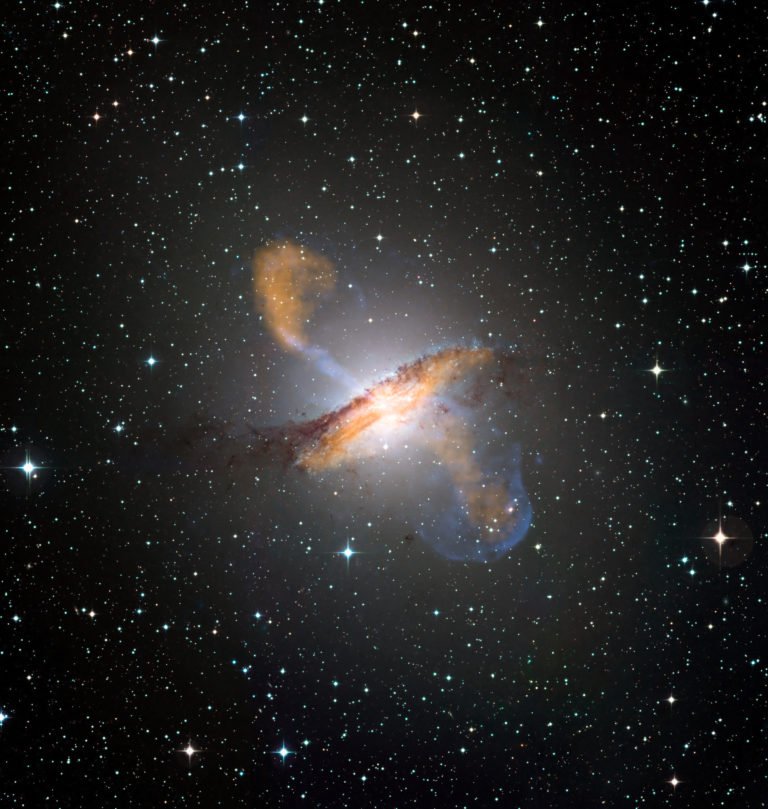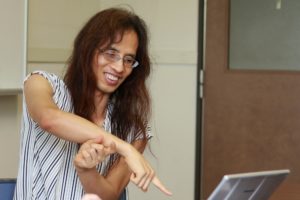On February 1, 2013, Hiroshima University established two new programs: the “Distinguished Professors” (DP) program and the “Distinguished Researchers” (DR) program. Individuals who are part of these programs are recognized as senior and junior faculty members respectively, who are engaged in extraordinarily distinguished research activities.
TELESCOPES IN SPACE
Professor Yasushi Fukazawa is an astronomer at Hiroshima University, but his telescopes are located in outer space.
Fukazawa is interested in X-rays and Gamma rays, types of light that the human eye cannot see and Earth-based telescopes are unable to detect. Earth’s atmosphere absorbs the X-rays and Gamma rays emitted by objects in space. To gather information about these types of energy, astronomers build telescopes and then rocket-launch them into orbit where they circle Earth as satellites. The Hubble Space Telescope may be the most famous of this type of satellite telescope. Traditionally, satellite telescopes primarily built in Japan are re-named after their successful launch. Fukazawa was involved in projects to develop instruments for three telescopes:
1. The Advanced Satellite for Cosmology and Astrophysics or ASCA (formerly Astro-D), launched in February 1993. ASCA allowed researchers from Europe, Japan, and the USA to observe X-rays until 2001 when a solar flare caused a geomagnetic storm that blew the satellite out of its orbit and it fell back into Earth’s atmosphere.
2. Suzaku, meaning Vermillion Bird (formerly Astro-E II), launched in July 2005. The Suzaku satellite carried three major X-ray detection instruments, one of which malfunctioned within weeks of launch. However, the two other instruments collected data for nearly ten years.
3. Hitomi, meaning pupil of the eye (formerly Astro-H), launched in February 2016. The satellite was lost in late March due to failure of the altitude control mechanisms.
“I worked on the instrument on Hitomi that would have observed Gamma rays since… 10 years ago,” Fukazawa says, pausing to count the time. “I feel it is very, very unfortunate what happened. The telescope did successfully make some brief observations, so we are analyzing the data now.”
One of the short observations Fukazawa refers to was a two-hour long test exposure of the Crab Nebula, which was originally performed only to verify that the equipment was working properly. The Soft Gamma ray Detector (SGD) equipment that made the measurements could observe the energy level and direction of Gamma rays with significantly less background noise signals than was possible with equipment on previous telescopes. A major improvement was that Hitomi’s SGD could also detect the orientation, or polarization, of the Gamma rays, meaning scientists could study the process of how are emitted. The Crab Nebula is a supernova remnant, a gas cloud that extends for about 10 light-years and has a pulsar, or neutron star, at its center. Pulsars rotate and emit high-energy wavelengths of light; astronomers detect a pulse of this light at the moment when the star faces Earth during each rotation, which is why these stars are sometimes compared to lighthouses. Previous observations indicated that the Crab Nebula pulsar emits X-rays that are polarized, so the Hitomi satellite was gathering data to more conclusively study the pulsar.

The Crab Nebula is approximately 10 light-years wide and contains a neutron star, or pulsar, at its center. Fukazawa has studied the polarization of light emitted from the neutron star at the center of this nebula. Image Credit: NASA, ESA, J. Hester, A. Loll (ASU) https://www.nasa.gov/multimedia/imagegallery/image_feature_1604.html
Rather than light waving or oscillating at all angles, polarized light is made of light waves all waving or oscillating in the same direction. Polarized sun glasses, popular for reducing visual glare from the ocean or snow, create an example of artificial polarized light. The material of the glasses lens blocks light traveling in any direction except one. The polarized light, light waves moving in that one direction, is the only light that reaches the eyes. Understanding exactly how the light from the Crab Nebula pulsar is polarized would give researchers a better understanding of the nebula and, potentially, other pulsars.
Ideally, Hitomi’s full experimental observation of the Crab Nebula would have lasted 1.5 days. researchers can use mathematical calculations to reduce the signal-to-noise ratio of the two-hour test observation to salvage some new data from Hitomi’s brief functional time in space. Fukazawa predicts that it may take six months to process the data before they have some information that they can begin to interpret.
EARLY BEGINNINGS
Fukazawa graduated with Bachelor, Master, and Ph.D. degrees from the University of Tokyo, finishing in 1995, and has been a faculty member of Hiroshima University in the Graduate School of Science since 2000. He currently teaches undergraduate and Master’s level courses in astrophysics and astronomy, and supervises Ph.D. candidates.
His interest in astronomy began early and did not waver.
“As a child, I asked my parents to buy a telescope, but they did not accept this idea,” Fukazawa says. “Eventually, my grandmother purchased one for me. I enjoyed seeing the sky with that telescope. I also enjoyed the TV program of Carl Sagan. He explained Einstein’s special relativity theory. I remember that very well.”
The program, Cosmos: A Personal Voyage, first aired with Carl Sagan as host in 1980. Sagan was an active research astronomer at Cornell University in America, but became a household name around the globe due to his efforts to make astronomy accessible to non-scientists. Fukazawa has incorporated the public outreach exemplified by his childhood hero into his own career. He gives public lectures usually twice per year; one lecture is attended mostly by high school-aged students and the other is popular with local adults.

Fukazawa reflects on his own childhood interest in astronomy and reasons why non-scientists may be interested in space research.
“I think people are interested in massive-scale phenomena which cannot be realized in their daily life. Objects and events in astronomy are so big and so unfamiliar, you need your imagination to understand them and everyone can enjoy thinking like this. Many people are interested in the universe, so I think it is important to let them know about new results.”
EARTH INSTRUMENTS
Fukazawa has also developed Earth-based applications for some of the instruments he originally built for space telescopes. Two types of double-sided strip Gamma ray detectors, made of silicon and cadmium-telluride have been adapted for non-astronomy uses on Earth. Gamma rays are caused by radioactive decay, so detecting Gamma rays in space using telescopes relies on the same scientific principles of identifying radioactivity on Earth. The scientific principle that was first used to build Gamma ray detectors is known as Compton scattering and was recognized with the 1927 Nobel Prize in Physics. When a particle of light interacts with another particle, the light is scattered and its wavelength shifts to a lower energy level. That shift is measurable and allows researchers to calculate the origin and trajectory of the light wave.
Events like the damage to the Fukushima nuclear reactor can scatter radioactive isotopes into the environment. Most radioactivity monitors, like the classic clicking of Geiger counters, can only identify if any radioactivity is present in the immediate vicinity at the present time. In 2013, Fukazawa worked with a research team at Hiroshima University and industry collaborators to develop a portable camera that can be used in the field to identify the intensity, location, and type of radioactive isotopes in real time.
“Similar technology already exists, but the uniqueness of our design was to create a spectrum that can identify what type of radioactive isotope is emitting the Gamma rays. When we know exactly what type of radioactive isotope we are detecting, we can make a confident identification of the source of that radioactivity,” says Fukazawa.

Fukazawa considering the Earth-based applications of satellite telescopes.
Researchers and recovery personnel know that the Fukushima disaster released large amounts of Cesium. If survey teams detect radioactive Cesium in surrounding locations using the new portable camera, the radioactivity is likely from Fukushima. Detecting other types of radioactive isotopes may indicate that another source should be investigated. Identifying the source of radioactivity allows scientists and governments to understand how radioactive isotopes move through environments and to assess the effectiveness of different control measures.
ONGOING PROJECTS
Currently, Fukazawa is involved in efforts to develop silicon sensors for the Fermi Gamma ray Large Area Space Telescope, which was originally launched into space in June 2008. Hiroshima University is Japan’s representative organization for the Fermi project. Gamma rays pass through most materials, meaning they do not reflect off of mirrors like visible light waves in optical telescopes. The silicon sensors precisely measure the angle of incoming Gamma ray particles; a telescope equipped with this instrument can determine the precise location of a Gamma ray source.

Fukazawa’s research is investigating the active star-forming galaxy Centaurus A. Two lobes of light waves project out from the center of this galaxy where a supermassive black hole is also located. Image Credit: ESO/WFI (Optical); MPIfR/ESO/APEX/A.Weiss et al. (Submillimetre); NASA/CXC/CfA/R.Kraft et al. (X-ray) http://www.eso.org/public/images/eso0903a/
Previous work using the Fermi telescope made observations of Centaurus A, one of the closest radio galaxies to Earth. A supermassive black hole exists at the center of Centaurus A, but a beaming jet either within or very near to this black hole emits X-rays and radio waves that travel out into space for thousands of light-years. Researchers see the waves in telescope data as two lobes projecting out of the galaxy, like a single stroke through the middle. The classic concept of black holes absorbing everything and emitting nothing may be incorrect.
“Radio-wave observations have shown us that this black hole exists and is ejecting the jet. But we must observe it at higher energy wavelengths using X-ray and Gamma ray detectors so we can understand exactly what it is doing,” says Fukazawa.
The logistics of these types of observations, of obtaining results using multiple instruments on telescopes that are impossible to physically access, is part of the work’s appeal for Fukazawa.
“One interesting aspect of this research is to plan the observation. To observe an astronomical object, we must plan when to perform the observation based on different astronomical conditions or events. Sometimes we want to observe the object with different instruments, so we must plan how to coordinate the simultaneous observations of different telescopes. The other interesting part of astronomy is to analyze the data and it is exciting when we obtain the results,” says Fukazawa.

Yasushi Fukazawa enthusiastically demonstrates the apparent activity of X-ray and Gamma ray jets on the edges of black holes.
“Then after we obtain the results, we must write the paper. That part of the work, it takes a long time. Honestly, to write papers is not the part that I enjoy.” Despite his dislike of writing papers, Fukazawa has co-authored over 400 research papers, as of September 2016. The goal of making new discoveries about the universe that he can share with colleagues and the general public alike is Professor Fukazawa’s motivating factor.

 Home
Home